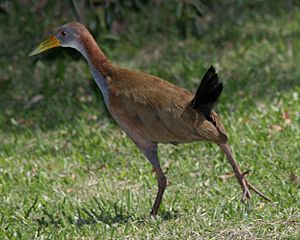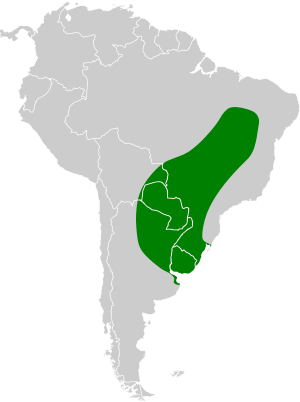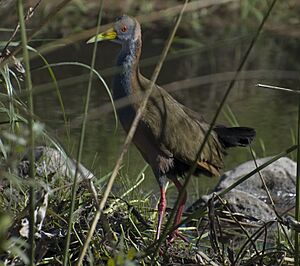Giant wood rail facts for kids
Quick facts for kids Giant wood rail |
|
|---|---|
 |
|
| Conservation status | |
| Scientific classification | |
| Genus: |
Aramides
|
| Species: |
ypecaha
|
 |
|
The giant wood rail (Aramides ypecaha) is a large and interesting bird that belongs to the rail, crake, and coot family, Rallidae. You can find this bird in several South American countries, including Argentina, Bolivia, Brazil, Paraguay, and Uruguay.
Contents
What the Giant Wood Rail Looks Like
The giant wood rail is a big bird, usually about 41 to 45 centimeters (16 to 18 inches) long. Some have even been measured up to 53 centimeters (21 inches) long! Both male and female giant wood rails look very similar.
Adult birds have a bright mustard yellow beak and striking red eyes. Their legs and feet are also red. The feathers on their face and upper chest are a bluish-gray color, with a white chin. The back of their neck is a pretty rust-red, while their back is olive green. The feathers covering their tail and the tail itself are black. The sides of their body, chest, and belly are a brownish-pink. We don't have much information about what young giant wood rails look like.
Where the Giant Wood Rail Lives
You can find the giant wood rail in eastern Bolivia, central and southeastern Brazil, Paraguay, Uruguay, and northeastern Argentina. This bird prefers to live in flat, low-lying areas. It loves wet places like marshes and swamps that have some trees. You might also spot it in forests that grow along rivers, called gallery forests, or in fields and pastures close to water and good hiding spots.
Giant Wood Rail Behavior
How the Giant Wood Rail Moves Around
The giant wood rail seems to be a bird that stays in the same place all year. It doesn't usually travel long distances or migrate to different areas.
What the Giant Wood Rail Eats
Scientists don't know a lot about how the giant wood rail finds its food or exactly what it eats. However, people have seen it digging in the soil, probably looking for food. There's even a photo of one carrying a snake! This bird is known to look for food in open areas more often than other birds in its family.
Reproduction and Life Cycle
We don't know exactly when the giant wood rail's breeding season is. This bird builds its nest using grasses and plant stems. It usually places the nest in a shrub or tangled plants, about a meter (or more) above the water. A female giant wood rail typically lays four or five eggs. When these birds are kept in captivity, their eggs hatch after about 24 days. The baby chicks leave the nest after only about four days. Both parents take care of the young birds for up to nine weeks.
Giant Wood Rail Sounds
The giant wood rail is a very noisy bird! It calls out a lot during the day and in the evening. Several birds might gather together and make an amazing, very loud chorus of screams, shrieks, and wheezes. It can be quite a powerful sound!
Giant Wood Rail Status
The IUCN (International Union for Conservation of Nature) has listed the giant wood rail as a species of "Least Concern." This means that, for now, it's not considered to be in immediate danger of disappearing. It lives across a large area, but we don't know exactly how many giant wood rails there are. Experts believe their numbers might be going down. No major threats have been found right now. Many people also keep these birds in captivity. However, in the wild, their numbers have likely decreased because a lot of their natural homes have been destroyed.
See also
 In Spanish: Ipacaá para niños
In Spanish: Ipacaá para niños



